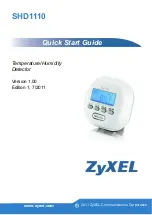
Chapter 8 NAT
NR2101 User’s Guide
85
different LAN computer, you have to manually replace the LAN computer's IP address in the forwarding
port with another LAN computer's IP address.
Trigger port forwarding solves this problem by allowing computers on the LAN to dynamically take turns
using the service. The NR2101 records the IP address of a LAN computer that sends traffic to the WAN to
request a service with a specific port number and protocol (a "trigger" port). When the NR2101's WAN
port receives a response with a specific port number and protocol ("incoming" port), the NR2101
forwards the traffic to the LAN IP address of the computer that sent the request. After that computer’s
connection for that service closes, another computer on the LAN can use the service in the same
manner. This way you do not need to configure a new IP address each time you want a different LAN
computer to use the application.
8.3.4 Trigger Port Forwarding Example
The following is an example of trigger port forwarding.
Figure 89
Trigger Port Forwarding Process: Example
1
Jane requests a file from the Real Audio server (port 7070).
2
Port 7070 is a “trigger” port and causes the NR2101 to record Jane’s computer IP address. The NR2101
associates Jane's computer IP address with the "incoming" port range of 6970-7170.
3
The Real Audio server responds using a port number ranging between 6970-7170.
4
The NR2101 forwards the traffic to Jane’s computer IP address.
5
Only Jane can connect to the Real Audio server until the connection is closed or times out. The NR2101
times out in three minutes with UDP (User Datagram Protocol), or two hours with TCP/IP (Transfer Control
Protocol/Internet Protocol).
8.3.5 Two Points To Remember About Trigger Ports
1
Trigger events only happen on data that is coming from inside the NR2101 and going to the outside.
2
If an application needs a continuous data stream, that port (range) will be tied up so that another
computer on the LAN cannot trigger it.
Summary of Contents for NR2101
Page 9: ...9 PART I User s Guide...
Page 55: ...55 PART II Technical Reference...
















































